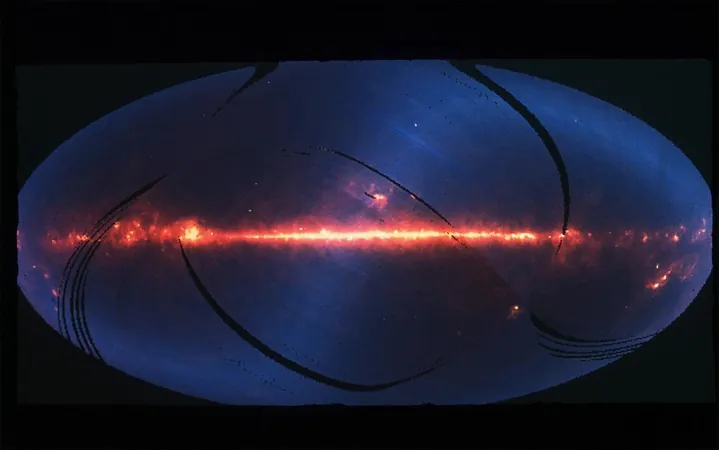
Unlocking the Invisible Universe: How William Herschel Paved the Way
2025-05-29
Author: Ling
Did you know that our eyes only capture a tiny fraction of the universe? While there are around 80 octaves of electromagnetic radiation out there, we are only able to perceive the narrow band of colors that lies between violet and red. This means that 79 unseen octaves are constantly surrounding us, hiding everything from cosmic wonders to the very fabric of reality.
Yet, thanks to technology, we are breaking free from these biological limitations. Enter the James Webb Space Telescope (JWST), a marvel of modern engineering that allows us to venture beyond the visible spectrum, into the infrared. This groundbreaking tool has been scanning the skies, revealing a hidden universe that is reshaping our understanding of cosmic phenomena.
JWST: Our Cosmic Eye
Located a million miles from Earth, the JWST has spent three years exploring infrared radiation. With its giant 6.5-meter mirror made up of 18 hexagonal segments, it absorbs a million times more light than our retinas do. This telescope isn’t just capturing images; it's converting light waves into data that scientists interpret into breathtaking visuals of star formations and galaxy collisions.
This extraordinary project represents a two-century-long desire to expand human perception. The JWST is not only the most complex observatory ever launched but also the most sophisticated 'bionic eye' connected to our consciousness, allowing us a glimpse into the depths of space.
A Legacy of Discovery: The Role of William Herschel
The JWST's incredible capabilities are rooted in the revolutionary work of British astronomer William Herschel, best known for discovering Uranus in 1781. Herschel's pioneering experiments in the early 1800s set the stage for modern infrared exploration.
While trying to observe solar rays without damaging his eyesight, Herschel discovered infrared rays—wavelengths undetectable by the human eye but capable of transmitting heat. His frustration with the limitations of visible light spurred him to extend his experiments into the infrared realm, ultimately uncovering an entire spectrum of reality that was previously beyond our senses.
From Frustration to Revelation: Herschel's Breakthrough
Herschel’s pivotal experiment involved using a prism and thermometers to measure temperature variations across the spectrum of light. When he ventured past the red end of the spectrum, he was stunned to find that his instruments still registered heat. This groundbreaking revelation pushed the boundaries of what was known about light and heat—yet it left many questions unanswered.
Herschel coined terms like 'radiant heat' and elaborated on the concept of an 'invisible spectrum' beyond human perception. His exploration hinted at the idea that our sight is adapted only to receive impressions that will aid survival, leaving us blind to a myriad of realities.
Infrared Astronomy: Slow Advances Towards Enlightenment
Despite Herschel's monumental achievements, the exploration of the infrared spectrum lagged for decades due to technological limitations. It wasn't until the mid-20th century that significant advancements were made. Charles Piazzi Smyth detected infrared rays from the Moon in 1856, effectively reigniting interest in the invisible world.
Tools like the bolometer and lead-sulfide detectors opened the door to further discoveries, culminating in the launch of the Infrared Astronomical Satellite (IRAS) in 1983. IRAS uncovered a treasure trove of infrared sources, revealing new layers of the universe previously concealed from us.
The JWST: A Transformative Experience
Today, the JWST represents a monumental leap forward, extending our infrared vision further than ever before. With its advanced technology, it has begun to reveal the very secrets of the universe, including the most distant galaxy known—JADES-GS-z14-0, observed from a staggering 13.4 billion years ago.
As we marvel at these discoveries, we must remember that this journey began with Herschel's simple but profound experiments. JWST not only enhances our perception; it reshapes our understanding of existence. As the pioneering philosophers Andy Clark and David Chalmers suggested, our cognitive experience expands as we integrate technology into our sensory toolkit, helping us see the universe more accurately than ever before.
In a world where technology breaks the boundaries of human limitation, we continue to journey deeper into the cosmos—and with each discovery, we uncover yet another layer of the previously invisible universe.




 Brasil (PT)
Brasil (PT)
 Canada (EN)
Canada (EN)
 Chile (ES)
Chile (ES)
 Česko (CS)
Česko (CS)
 대한민국 (KO)
대한민국 (KO)
 España (ES)
España (ES)
 France (FR)
France (FR)
 Hong Kong (EN)
Hong Kong (EN)
 Italia (IT)
Italia (IT)
 日本 (JA)
日本 (JA)
 Magyarország (HU)
Magyarország (HU)
 Norge (NO)
Norge (NO)
 Polska (PL)
Polska (PL)
 Schweiz (DE)
Schweiz (DE)
 Singapore (EN)
Singapore (EN)
 Sverige (SV)
Sverige (SV)
 Suomi (FI)
Suomi (FI)
 Türkiye (TR)
Türkiye (TR)
 الإمارات العربية المتحدة (AR)
الإمارات العربية المتحدة (AR)